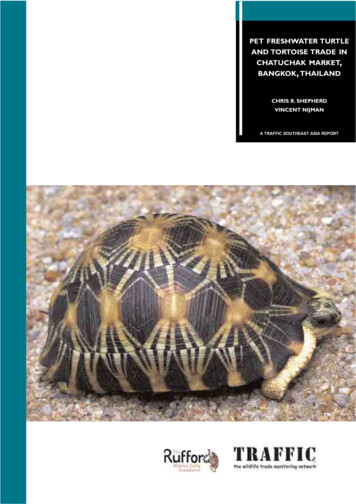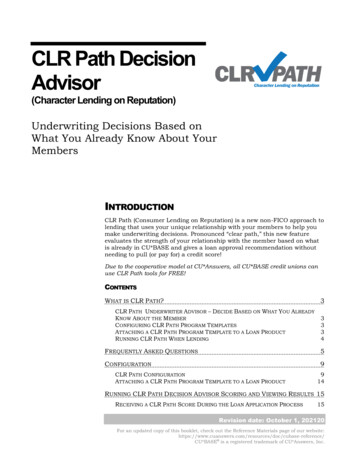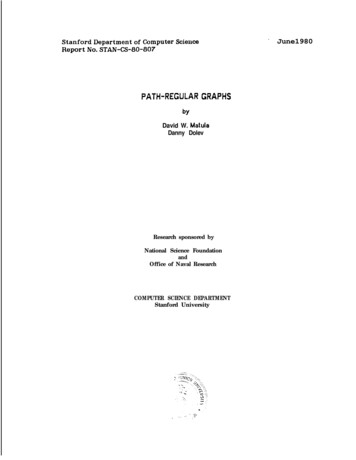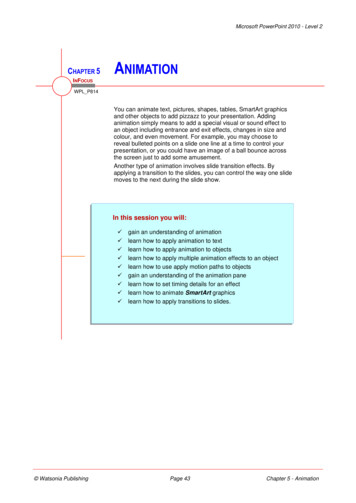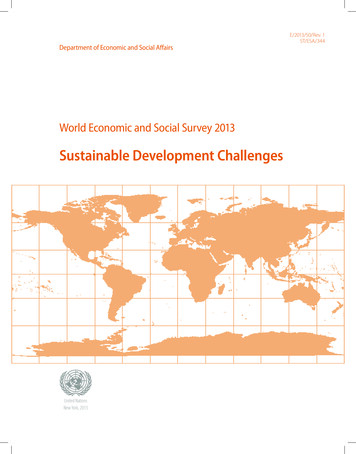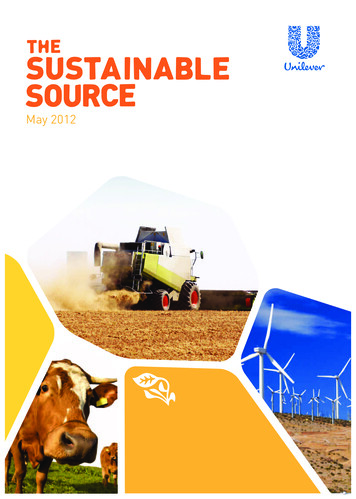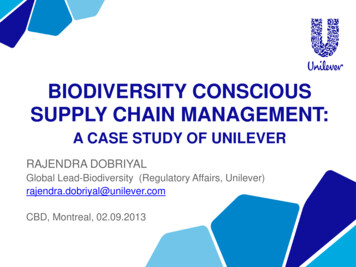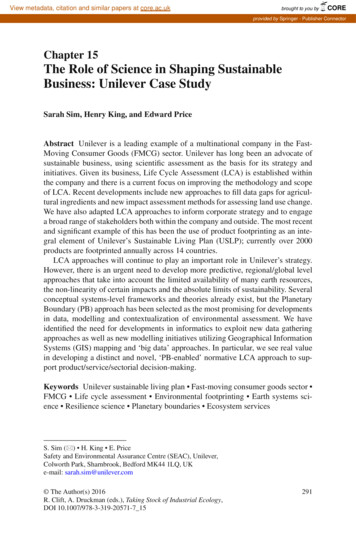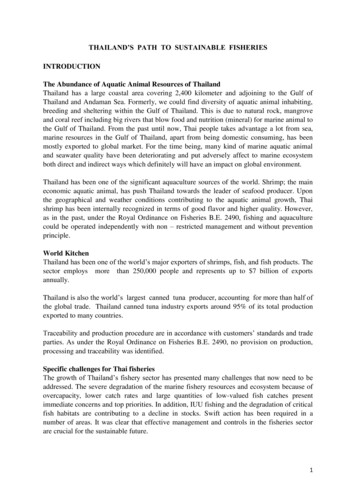
Transcription
THAILAND’S PATH TO SUSTAINABLE FISHERIESINTRODUCTIONThe Abundance of Aquatic Animal Resources of ThailandThailand has a large coastal area covering 2,400 kilometer and adjoining to the Gulf ofThailand and Andaman Sea. Formerly, we could find diversity of aquatic animal inhabiting,breeding and sheltering within the Gulf of Thailand. This is due to natural rock, mangroveand coral reef including big rivers that blow food and nutrition (mineral) for marine animal tothe Gulf of Thailand. From the past until now, Thai people takes advantage a lot from sea,marine resources in the Gulf of Thailand, apart from being domestic consuming, has beenmostly exported to global market. For the time being, many kind of marine aquatic animaland seawater quality have been deteriorating and put adversely affect to marine ecosystemboth direct and indirect ways which definitely will have an impact on global environment.Thailand has been one of the significant aquaculture sources of the world. Shrimp; the maineconomic aquatic animal, has push Thailand towards the leader of seafood producer. Uponthe geographical and weather conditions contributing to the aquatic animal growth, Thaishrimp has been internally recognized in terms of good flavor and higher quality. However,as in the past, under the Royal Ordinance on Fisheries B.E. 2490, fishing and aquaculturecould be operated independently with non – restricted management and without preventionprinciple.World KitchenThailand has been one of the world’s major exporters of shrimps, fish, and fish products. Thesector employs more than 250,000 people and represents up to 7 billion of exportsannually.Thailand is also the world’s largest canned tuna producer, accounting for more than half ofthe global trade. Thailand canned tuna industry exports around 95% of its total productionexported to many countries.Traceability and production procedure are in accordance with customers’ standards and tradeparties. As under the Royal Ordinance on Fisheries B.E. 2490, no provision on production,processing and traceability was identified.Specific challenges for Thai fisheriesThe growth of Thailand’s fishery sector has presented many challenges that now need to beaddressed. The severe degradation of the marine fishery resources and ecosystem because ofovercapacity, lower catch rates and large quantities of low-valued fish catches presentimmediate concerns and top priorities. In addition, IUU fishing and the degradation of criticalfish habitats are contributing to a decline in stocks. Swift action has been required in anumber of areas. It was clear that effective management and controls in the fisheries sectorare crucial for the sustainable future.1
2I Achieving sustainability for our fisheries sectorEnvironment : Thailand has had for centuries a policy of open access to the sea. Thailandhas thousands of kilometers of coastline, and the sea has been a major source of food andeconomic activity for many local communitiesWorking toward greater sustainability will be long journey. In 2015 and 2016, Thailand madevery important first steps to control its fleets and their activities. Thailand updated its legalframework for fisheries through the Royal Ordinance on Fisheries (2015) and MarineFisheries Management Plan of Thailand 2015 – 2019. Under the Royal Ordinance onFisheries, national fisheries has been shifted from open access to limited access according toMaximum Sustainable Yield (MSY), monitoring, control and surveillance (MCS) has beenused as a tool to manage fisheries in order to encounter situation and issues may rise.Social: The diversity of marine resources leads to the number of various fishing gears, smalland large scale of fishers differ in social and economic conditions. It is found that registeredfishing vessels are approximately 39,000 vessels and more than 71% are artisanal fishingboats of less than 10 gross tonnage. Under the Royal Ordinance on Fisheries has aimed toprovide protection to artisanal fishers in order to allow them to fish independently and noneed to request for permission. This is due to that it is considered as burden for them exceptfor effective fishing gears that need to be under controlled. Moreover, coastal zonedemarcation has been specified and imposed commercial fishing vessels of 10 gross tonnageand over to not enter the demarcated zone.Economic: Fishery situation of Thailand has been under “open access” condition,throughout the last 60 years, limited access has been challenge for Thailand to gothrough by allowing fishers to live their lives upon their career favorably in thetransition period.II Ending human trafficking and human rights abuses.Thailand’s growing economy at tracts every year many migrant workers from neighboringcountries in search of job opportunities, better wages and improved economic conditions fortheir families. Due to its geographical location, Thailand shares thousands of kilometers ofland borders with its neighbors and illegal migrants can enter the country relativelyundetected.Without identity papers, work permits or knowledge of the Thai language, illegal migrantworkers are vulnerable to exploitation. Since 2015, Thailand strengthened its legalframework for a better protection of workers and regularization of illegal migrant workers.The Royal Thai Government recognizes the need to devise effective prevention. All lineagencies are prepared to amend existing laws, where and when necessary, and ready to issuenew regulations to make prevention more effective. Existing measures that have proven towork well in the past are also systematically implemented to deter trafficking in persons,labour violation, and curtail pull factors. The authorities concerned put in place preventivestrategies for specific groups, in this case especially for every labour who work and stay inThailand. The Government has devoted a lot of effort in the areas of labour management,labour inspection, capacity building and training of frontline officers, awareness raising,enhancing law enforcement and alignment with international standards in order to achieveoptimal preventive effects.
3III Respecting the international level- playing field.Until recently, there was no framework in place for the Thai authorities to control the activityof these vessels at sea. On land, greater accountability had already been established to fulfilltraceability and food safety requirements of international buyers, including for EU , USAand other markets.It is important to strengthen oversight over tuna landed in Thai ports by non-Thai vessels. AsPart of reforms, Thailand acceded in May 2016 to the FAO’s Port State MeasuresAgreement, enhanced the traceability of fish catches and began a strict enforcement of it newrules.I ACHIEVING SUSTAINABILITY FOR THAILAND’S FISHERIES SECTORThailand’s Fleet structure and Fishing licenseThe most importance of fishing management is the accurate number and structure of fishingfleet. The Marine Department has launched several campaigns of inspection since November2015, either individually or jointly with the Department of Fisheries, the Royal Thai Navy,and the Department of Provincial Administration, Ministry of Interior, primarily with theobjective to verify the vessels’ existence and status. On 9 September 2016, the NCPO OrderNo. 53/2559 “Resolution of Problems Pertaining to Illegal, Unreported, and UnregulatedFishing: 3rd Amendment” was issued as a legal instrument to control unregistered fishingvessels and registered fishing vessels without fishing license by having them identify theirlocation. If the vessels were found in existence, they were subject to be controlled by theMarine Department by means of securing the vessel steering helm with a cable seal to restrictthe vessel’s mobility. Registered fishing vessels without fishing license are required tosuspend their use, or change its type of use to non-fishing purpose. If they failed to do so, thevessel registration would be consequently revoked. On 4 April 2017, the NCPO Order No.22/2560 “Resolution of Problems Pertaining to Illegal, Unreported, and Unregulated Fishing:4th Amendment” provided an additional instrument to solve the problem of fleet managementand control by initiating a new round of inspection for Thailand’s overall fishing vessel fleet,including registered fishing vessels with or without fishing license and those vessels whoseregistration was revoked on or after the date of entry into force of NCPO Order No. 10/2558.Any vessels which failed to participate in the inspection or failed to report their location tothe Marine Department would be subject to control measures, such as securing the steeringhelm, withdrawing the fishing license, and possibly revoking the vessel registrationIn 2017, Thailand has 39,060 fishing vessels comprising 27,924 artisanal fishing boats of lessthan 10 gross tonnage, 11,145 commercial fishing vessels including 10,584 commercialfishing vessels with commercial fishing license, and only 2,565 of them are of over 60 grosstonnage. Thailand has 75 transshipment vessels, all of them transships fish domestically,moreover, there are 8 refrigerated fishery cargo carriers internationally transferring fish fromport to port. Under Royal Ordinance on Fisheries, it is specified that commercial fishinglicense will be issued “in compliance with fishing capacity and maximum sustainable yield”In 2015 - 2016, the MSY assessment was done for three different groups, namely, demersalfish, pelagic fish, and anchovy. In 2017, to achieve a more effective management of marineresources, the MSY assessment has been done in nine species or groups. Thailand has granted
4commercial fishing license for 11,237 commercial fishing vessels of over 10 gross tonnage,the license will be valid for 2 years and some of them have been revoked. In 2018, Thailandhas imposed that fishing vessel of less than 10 gross tonnage installing effective fishing gearssuch as trawler and anchovy falling net must request for commercial fishing license in orderto allow fishing management more effective.Monitoring, Controls, and Surveillance (MCS)LogbookThailand has started using the logbook since 2010. The logbook usage was first on avoluntary basis and aimed to report the fishing operation of fishing vessels and its catch tothe DOF agencies for traceability. At first, there were five types of logbook for such fishinggears as trawlers-push net, surrounding net, drift net, falling/lift/net, trap, and others.In 2015 – 2016 , Thai commercial fishing vessel sizing 30 GT and over as well as everyvessel using trawler, purse seine, and anchovy falling net have been placed under theregulation to implement logbook on a compulsory basisIn 2017, commercial fishing vessels of over 10 gross tonnage must implement Logbook. Thelogbook form has been improved to report the geographic position (latitude and longitude),where the fishing activity is conducted. DOF increased the number of types of logbook to 16types according to licensed fishing gearsVMS & ERS/EM – Real-time InspectionsUnder the Royal Ordinance, commercial of 30 gross tonnage and over must install VesselsMonitoring System (VMS) for tracing its position and fishing activities. About 6,000 Thaiflagged fishing vessels of 30 GT in size or larger and their activities are monitored at realtimes 24 hours a day through VMS. This includes approximately 2,800 vessels of 60 GT insize or larger. The number of vessels monitored by VMS represents 15 percent of the Thaifleet, which contains 39,069 vessels in total, but almost all commercial fishing vessels.During the first half of 2017, DOF officials conducted a comprehensive operation to seal allVMS devices in order to prevent a possibility of VMS device removal from the vessel. TheVMS seal is to be also checked by PIPO inspectors when conducting vessel inspection, everytime when the vessels port in and port out. In order to ensure that VMS is switched on at alltime, the DOF has improved its Standards of Operation Procedure (SOP) for the FMC teamto take immediate actions when VMS signals are lost or irregular. In addition, as a long termmeasure, the DOF has required the new set of VMS devices or the so-called “VMSGeneration II” with a tampering proof technology duly replace the VMS Generation I. Thiswill help the DOF official to efficiently detect VMS tampering.It is significant to control those refrigerated fishery cargo carriers transshipping fish oversea,this is to ensure that they are in line with international rules and regulation. The newelectronic surveillance system has been developed, comprising two main components:Electronic Reporting System (ERS) and Electronic Monitoring System (EM).The Electronic Reporting System (ERS) is where the DOF staff can effectively control theoversea transshipment activities via satellite communication, request forms and reports, andupon the submission from the vessel, DOF staff can make a response. Electronic documents
5include transshipment request, transshipment declaration, fishing logbook, crew transferrequest, loading/landing request, and loading/landing declaration.The Electronic Monitoring System (EM) is a mechanism to audit fishing and transshipmentactivities at sea in near real-time manner. EM comprises electronic sensors, CCTV system,and broadband satellite communication. The sensors will automatically give the informationabout fishing and transshipment activities. Once a sensor is triggered, an electronic messageas well as the corresponding snapshot extracted from CCTV will promptly be sent to DOF tonotify of such activity. In addition, CCTV will continuously record the whole trip and, whenthe vessel is back to port, such video will be inspected by the DOF staff. The first inspectionwill be to follow up the instruction for inspection of the DOF staff, where focus is given tothe period in the video that the inspection was instructed. The inspection is carried out onboard of the vessel and finished within 24 hours after port-in. The extending period ofinspection will be carried out after collecting the video from the vessels.Port-In Port-Out (PIPO) – facilitates day-to-day enforcement28 Port –In Port Out (PIPO) Control Centers, operational since May 2015 , have been set upin 22 coastal provinces nationwide. Four more PIPO Control Centers and 15 ForwardInspection Points (FIPs) will be established by the end of 2016. In 2017, four additional FIPshave been established for enhance effectiveness of PIPO’s performance.At PIPO Control Centers, it is important to recall that the Thai authorities have set cleartargets for port-in and port-out inspections i.e. documentation and physical checks of vesselsand labor are carried out by PIPO officers and inspectors of relevant competent authorities.This means that all Thai-flagged vessels operating in Thai waters and wishing to PO or PIhave to be physically inspected by the Thai authorities before they are permitted to leave forfishing (PO) or return to land their catch (PI). Two types of Thai-flagged vessels which mustreport to PIPO namely (1) Fishing vessels of 30 GT (2) Fishing vessels of 10 - 30 GTwith three types of fishing gears: 1) trawler, 2) purse seine and 3) anchovy falling net. Inaddition, Thai-flagged carrier vessels also have to report to PIPO i.e. All fish carrier vessels(of any size), Reefers of 30 GT (other than fish carriers), Other support vessels of 30 GT(including freshwater transport vessels, Fisheries oil tanker, etc. ).To increase PIPO Control Centers’ efficiency, an electronic system called “Fishing Info II”has been introduced to facilitate PIPO operations. The Fishing Info II is now upgraded andable to effectively integrate the VMS database, the Marine Department database, E-license ofDOF and fishing logbook in the system. The upgraded system will further strengthen theoperation of PI and PO permission by automatic screening, verifying, reporting and rejectionof non-compliance vessels, in order to avoid human errors. The current Fishing Info II systemwhich supports a central risk-based assessment will process the automated checks of Thaivessel registration, vessel license, fishing license, the vessel’s lock status, and the VMSstatus.In order to obtain, and verify the actual weight and species of fish caught by Thai-flaggedvessels at fish landing sites, the DOF has developed a landing declaration form to be filledby the owner of fish landing sites where the fish is offloaded and submitted to DOF officials.
6Landing and post-harvest controlUnder the Royal Ordinance, commercial fishing vessels must dock at the port registered withthe Department of Fisheries. There are totally 1,058 registered ports consisting of 1,024fishing ports that have stood up to port sanitary inspection.Information on port in and port out of fishing vessels must be reported such as its name,arrival and departure times including catches volume transshipped at port in case fish hasbeen landed at port.To control catch at landing sites, DOF has applied an electronic system for recordinglandings at the fishing ports since October 2016. The first pilot project was run in threefishing ports of the Fishery Marketing Organization in Songkhla, Ranong and Phuketprovinces in October 2016. DOF is then under expanding the usage to private fishing portsaround the country.In October 2017, DOF organized the training course for all staff of ports through which catchare intended for exports on how to record the catch data into the electronic system. Theinspection result shows that all target fishing ports understand the regulation and are able torecord data correctly in the system.
7II ENDING HUMAN TRAFFICKING AND HUMAN RIGHT ABUSES.Legislative Framework1) Conducting gap analysis study on the existing laws and the provision of the ILOConvention Work in Fishing Convention No.188 (C188) and Protocol of 2014 to theForced Labour Convention, 1930 (P29) under the Ship to Shore Rights Project and tocomplete the process of ratification by 2017 ILO Work in Fishing Convention 188 (2007)The Ministry of Labour and relevant government agencies are in the process of amendingrelevant government rules and regulations in accordance with the Convention. In this processof legal amendments, consultations with employers and employees in the fishing industrywill be held. The amendments will be proposed to the Cabinet for endorsement by March2018, with a view to entering the ratification process in Geneva by June 2018. These lawswill ensure fishing workers’ rights to social insurance benefits and employers’ contribution toWorkmen Compensation Funds, as well as safety and health standards in fishing vessels. ILO Protocol of 2014 to the Forced Labour Convention, 1930 (P29)The Ministry of Labour is in the process of drafting the law on the prevention andsuppression of forced labour, in order to fulfil the requirements for the ratification of P029.The draft law will clearly define offences relating to forced labour, along with appropriatepunishments and the process of assistance, protection and rehabilitation for victims of labourexploitation, who are not qualified as victims of trafficking. The first draft is completed andhas been under the process of public hearing from stakeholders. It will subsequently beproposed to the Cabinet for endorsement by March 2018, before being presented to theCouncil of State for examination. It is expected that the draft law will be proposed to theNational Legislative Assembly for endorsement by April 2018, with the objective ofsubmitting the instrument of ratification in Geneva by June 2018.2) Continue to revise and amend the Labour Relations Act B.E. 2518 (1975) and theState Enterprise Labour Relations Act B.E. 2543 (2000) to ratify the ILO Right toOrganise and Collective Bargaining Convention No. 98 (C98).The amendments to two sets of laws, namely the Labour Relations Act B.E. and the StateEnterprise Labour Relations Act B.E , as a foundation for the ratification of C98, areunderway. One of the essential amendments relates to migrant workers’ right to serve as acommittee member of a labour union. Public consultations will be held with all stakeholdersacross the country, including the civil society, in order to collect inputs for the improvementof both laws. These two sets of legislation are set to be completed by August 2018, with anaim to proceed with the ratification process by September 2018.Close Tripartite Collaboration in ‘Ship to Shore Rights Project’The Ministry of Labour collaborates with the International Labour Organization (ILO) andthe European Union (EU) under the Combatting Unacceptable Forms of Work in the ThaiFishing and Seafood Industry: Ship to Shore Rights Project, prominent progress under theproject are;1) Conducted the gap analysis study on the existing laws and the provisionof the ILO Convention Work in Fishing Convention No.188 (C188) and Protocol of 2014 tothe Forced Labour Convention, 1930 (P29)
82) Capacity building trainings for 178 government officials and labourinspectors to be more capacitated in identifying trafficking cases, labour exploitative cases infishing and fisheries industries.3) The Ministry of Labour, in collaboration with the International LabourOrganization (ILO) and Stella Maris, established the Stella Maris Seafarer’s Centre under theCombating Unacceptable Forms of Work in the Thai Fishing and Seafood Industry: Ship toShore Rights Project. The Centre works towards improving living conditions and providingassistance for workers in the fisheries and seafood processing industries, including workerswho are victims of exploitation. In 2017, the Stella Maris Seafarer’s Centre, Songkhla,provided assistance and advice to 1,339 Thai and migrant workers in total. Meanwhile, newcentres were opened in 2017 in the three provinces of Pattani, Chonburi and Rayong and, sofar have provided assistance and advice to 5,829 Thai and migrant workers (As of December2017).Prevention1) Awareness Raising on Labour RightsAs part of sustainable prevention strategies, the Ministry of Labour attaches importance toraising awareness among Thai and foreign workers on the threat of trafficking in persons bymeans of information dissemination, particularly on labour rights. To achieve the goal, a widespectrum of media outlets have been utilized to enable workers to easily access information,ranging from the social media, television, newspapers, magazines, advertisements, leafletsand other published documents. It is estimated that this public relations strategy haseffectively raised awareness among the target group of approximately 12,371,025 people in2017, compared to the previous year that saw an approximate number of 130,400 people ableto access such information, an increase by a factor of 952) Establishment of Post-Arrival and Reintegration CentresEstablished in the 3 provinces of Tak, Nong Khai and Sra Kaeo, the Post-Arrival andReintegration Centres for Migrant Workers serve as linkage points between workers andemployers. These Centres are responsible for handing over work permits to workers;providing training courses; identifying workers; and extending protection to workersreturning to their home country. In 2017, there are 287,706 migrant workers attended trainingcourses at the Centres.To ensure that migrant workers in Post-arrival and Reintegration Centres receive adequateinformation about their rights in their languages; Build on good practice of training in certaincentres. The Department of Employment developed and disseminated communicationmaterial in Cambodian, Laos, Myanmarese and English to provide post-arrival informationfor migrant workers entering Thailand under the MoU at all 3 Post-arrival and ReintegrationCentres, and also envisages a new role for the Centres to identify potential cases of humantrafficking and labour abuses, by organising short interviews at the end of process.3) Collaboration with Private Sector on ‘Good Labour Practices (GLP)’The Ministry of Labour in collaboration with the ILO and private sector encourages fisheries,shrimp farms, poultry and other relevant industries to implement GLP guidelines in order toimprove working conditions and the environment. The GLP has been implemented by 5,049establishments in 2017, compared to 499 establishments in 2016, a nine-fold increase.
94) Language CoordinatorsThe number of language coordinators hired by the Ministry of Labour rose 76.2 percent, from42 people in 2016 to 74 people in 2017.Additionally, a total of 60 language coordinators were hired by the Port In – Port OutControlling Centre (PIPO) in 2017, doubling the number over the previous year when 30language coordinators were hired.Prosecution and Enforcement1) Increasing number of Labour InspectorIn 2017, the number of labour inspectors has increased from 1,245 officers in 2016 to 1,506officers in 2017, representing a rise of 21 percent. Moreover, the Cabinet has approved therecruitment of 186 new labour inspectors for the current fiscal year, which will increase thenumber of labour inspectors to as many as 1,692 officers in 2018.2) Capacity Building for Labour InspectorDespite the training under Ship to Shore Rights Project, the Department of Labour Protectionand Welfare also organized five training courses in which 335 officers participated. Thesecourses sensitized participants to the various elements and manifestations of forced labourand taught them how to promote industry labour guidelines with a supportive good labourpractices training program. They additionally provided a valuable contribution to the effortsof finding sustainable solutions to the problems associated with illegal fishing.3) Labour InspectionsThailand has applied the principals of labour inspection guideline described in the ILOLabour Inspection No. 81 in conducting labour inspection. The result of labour inspectionduring 1 January – 31 December 2017 are as follows;- General Labour Inspection: Most violations are related to unpaid wages,absent of record of holidays, absent of workers list, absent of work conditions list, absent ofunpaid wage record etc.- Labour Inspections in High-Risk Areas (establishments that producesugarcane, garments, shrimp, fish, pig farms, etc. and the supply chain); Most violationsfound are related to unpaid wage, absent of record of rest hour and holiday, absent ofworkers’ name-list, absent of unpaid wage record, absent of work conditions, not setting upthe welfare committee etc.,- Labour Inspection on Fishing Vessels. Most violations found are relatedto absent of employment contract, absent of wage and unpaid wage record, absent of rest timerecord.- Compensation for workers in fishing vessels and seafood processingindustries. (Data as of 1 November 2017)
10Protection1) Establishment of Migrant Worker Assistance CentresThe Ministry of Labour partners with various NGOs in establishing Migrant WorkerAssistance Centres. These partner NGOs consist of International Organization for Migration(IOM); Human Resources Development Fund (HRDF); Labour Rights Promotion NetworkFoundation (LPN); Raks Thai Foundation; Migrant Workers Rights Network (MWRN); AidAlliance Committee for Myanmar Workers (AAC); Solidarity Committee for the ProtectionMyanmar Migrant Workers (SCPM); MAP Foundation for the Health and Knowledge ofEthnics Labour (MAP); Migrant Workers Federation (MWF); World Vision Foundation ofThailand; Marist Asia Foundation; and Stella Maris. Migrant Worker Assistance Centres arelocated in 10 provinces: Samut Sakorn, Surat Thani, Songkhla, Samut Prakarn, Chonburi,Ranong, Chiang Mai, Nakhon Ratchasima, Khon Kaen and Tak. Each centre has aninterpreter and provides an assortment of assistance to migrant workers, ranging fromeducation on benefits, workers’ rights and employment regulations. In 2017, a total of 57,498migrant workers were provided with assistance from these Centres, a 3-fold increase from theprevious year when 14,446 migrant workers were assisted.2) Stella Maris Seafarer CentresMinistry of Labour collaborated with the ILO and Stella Maris under the Ship to ShoreRights Project, to established 3 additional Seafarers Centres in (1) Fish MarketingOrganization, Pattani Province (2) Samae San Island, Chonburi Province and (3) Pak NamDistrict, Rayong Province. The Centres are aiming to improve quality of life for those whoare working in the fishing and fisheries industries and increase their access to services andnecessary assistances (detail as in Topic 6.2)Labour MigrationContinue to step up implementation of Nationality Verification System and LegalizationThe Department of Employment of the Ministry of Labour has facilitatedofficials from Thailand’s neighbouring countries in conducting nationality verification. In2017, governments from sending countries - Myanmar, Cambodia and Lao PDR - established14 One Stop Service Centres in Thailand to verify the nationality of their citizens. Thesecentres were able to verify 1,153,537 migrants, accounting for 57.7 percent of the totalnumber of 1,999,240 migrant workers who have been permitted to work in Thailandtemporarily.Legalizing migrant workers and allowing them to work with temporarypermits while going through the process of nationality verification are on-going measures thathave been developed and continuously improved upon since 2014. They constitute a“systemic reform in labour management” which helps prevent migrant workers frombecoming victims of labour exploitation. Additionally, establishing One Stop Service Centresin all of Thailand’s 76 provinces, which is still on-going, also enables the development of adatabase on migrant workers. Data collection is, in turn, beneficial for the provision ofprotection of migrant workers. Currently, a total of 1,999,240 migrant workers fromMyanmar, Cambodia and Lao PDR are allowed to work temporarily until 30 June 2018,while undergoing the nationality verification. A work permit and a visa are granted tomigra
Marine Department by means of securing the vessel steering helm with a cable seal to restrict the vessel's mobility. Registered fishing vessels without fishing license are required to suspend their use, or change its type of use to non-fishing purpose. If they failed to do so, the vessel registration would be consequently revoked.
